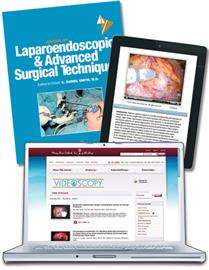Credit: ©Mary Ann Liebert, Inc., publishers
A new study shows that robotic video-assisted lung resection to remove a tumor achieves comparable outcomes with no significant differences in complications compared to conventional video-assisted thoracoscopic surgery (VATS), and robotic VATS (RVATS) may allow for preservation of more healthy lung tissue. The study, "Robotic Versus Thoracoscopic Resection for Lung Cancer: Early Results of a New Robotic Program" is published in Journal of Laparoendoscopic & Advanced Surgical Techniques (JLAST).
Benedetto Mungo, MD, Johns Hopkins University School of Medicine, Baltimore, MD, Daniela Molena, MD, Memorial Sloan Kettering Cancer Center, New York, NY, and coauthors compared the outcomes of patients with lung cancer who underwent minimally invasive segmentectomy or lobectomy using either VATS or RVATS. In addition to the types and rates of complications being similar for the two techniques, the authors reported fewer conversions to an open thoracotomy and more lymph nodes retrieved for testing with RVATS vs. VATS.
"It is well-known that the approach to a specific procedure rarely makes a difference when one compares the outcomes of robotic and thoracoscopic procedures," says Editor-in-Chief P. Marco Fisichella, MD, MBA, Harvard Medical School, Brigham and Women's Hospital, Boston VA Healthcare System, Boston, MA. "Mungo and Molena confirm this axiom in their work. Nevertheless, the robotic approach continues to gain acceptance, and rightly so. The robotic approach offers a valid and safe alternative to other minimally invasive treatments for lung cancer."
More information: Benedetto Mungo et al, Robotic Versus Thoracoscopic Resection for Lung Cancer: Early Results of a New Robotic Program, Journal of Laparoendoscopic & Advanced Surgical Techniques (2016). DOI: 10.1089/lap.2016.0049
Provided by Mary Ann Liebert, Inc


















